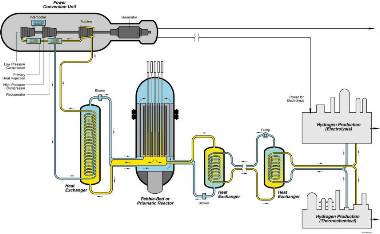The Next Generation Nuclear Plant (NGNP) project took another step forward on 15 August when the US Department of Energy (DoE) and Nuclear Regulatory Commission (NRC) submitted a joint licensing plan for the advanced reactor.
NGNP would feature a high temperature gas-cooled reactor configured to provide high-temperature heat (up to 950 °C) for a range of industrial uses such as fertilizer production, shale-oil recovery and coal-to-liquids, as well as hydrogen or electricity production. It would be built at Idaho National Laboratory and could operate in 2021, according to current statements. The design would be very different from the bulk of reactors in use for nuclear power production today, although not entirely different from some models used around the world.

How NGNP would be hooked up to provide industrial heat (Image: DoE)
The plan explains to Congressmen how the DoE, the NRC and potential builders of the plant would cooperate to license the new-design reactor for operation in time for construction to start in 2017. NRC chair Dale Klein said that the commission's current framework, geared towards light-water reactor designs, could also support a review of NGNP candidates and that NRC would "work with the DoE to supplement that framework with NGNP-specific items."
The NRC is already busy with certification work on light-water reactor (LWR) designs that electricity utilities are actively planning to build in the next decade and it is also expected to give a certain amount of attention to small and innovative reactor designs for potential future use.
The best strategy according to the plan would be to use the combined licence system, which is currently being used for the first time by commercial reactor buyers and builders. Existing risk-informed and performance-based licensing requirements could be adapted to create NGNP-specific requirements, while analytical tools currently used for LWRs could also be modified with appropriate models and data, the plan states.
Some areas would require regulatory development, including guides, review plans, codes and standards, reactor oversight process development and inspection. NGNP would also have some specific issues relating to security, safeguards, used nuclear fuel management, the environment, inspection and startup testing.
It is expected to take NRC about five years to assemble the necessary analytical tools, data and methods at a cost of $128-149 million for the period FY2008-18. The recommended strategy would see a licence application filed in 2013 following NRC preparations to start this year.
Three reactor designs are closely linked to NGNP through previous research and development deals with the DoE. There is General Atomics' GT-MHR; Areva's similar Antares design; and the Pebble Bed Modular Reactor (PBMR), backed by Westinghouse, South Africa's PBMR Pty, the Institute of Nuclear and New Energy Technology (INET) at China's Tsinghua University, the Shaw Group and Sargent and Lundy.




_47120.jpg)

_23621.jpg)






